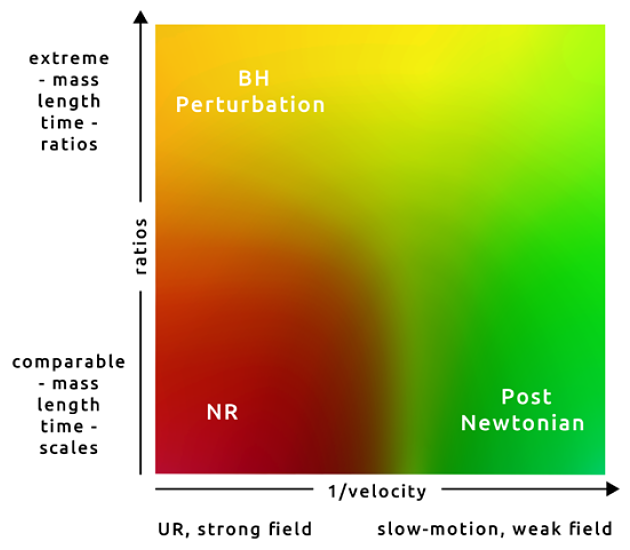1 Prologue
“Wir müssen wissen, wir werden wissen.” (We must know, we will know.)– D. Hilbert, Address to the Society of German Scientists and Physicians, Königsberg
(September 08, 1930).
One century of peering into Einstein’s field equations has given us elegant and simple solutions, and shown how they behave when slightly displaced from equilibrium. We were rewarded with a beautiful mathematical theory of black holes (BHs) and their perturbations, and a machinery that is able to handle all weak-field phenomena. After all, one hundred years is not a very long time to understand a theory with such conceptual richness. Left behind, as an annoying nuisance, was the problem of dynamical strong-field effects such as the last stages of BH mergers.
In the last few decades, it gradually became clear that analytical or perturbative tools could only go so far: gravitational-wave (GW) detectors were promising to see the very last stages of BH-binary inspirals; fascinating developments in String/M theory (SMT) were hinting at a connection between gauge theories and strong gravity effects; extensions of the standard model of particle physics were conjecturing the existence of extra dimensions, which only gravity had access to, and were predicting BH formation at accelerators! This, and more, required the ability to solve Einstein’s equations (numerically) in full generality in the nonlinear regime. The small “annoying nuisance” rapidly grew to become an elephant in the room that had to be tamed.
But necessity is the mother of inventions. In 2005, several groups achieved the first long-term stable evolutions of BH-binaries in four-dimensional, asymptotically flat spacetimes, starting a phase transition in the field. It is common to refer to such activity – numerically solving Einstein’s equations
or extensions thereof – as “numerical relativity” (NR). In practice, any numerical procedure is a means to an end, which is to know. In this sense, NR is a gray area which could lie at the intersection between numerical analysis, general relativity (GR) and high-energy physics. Many different numerical techniques have been used to solve the field equations in a variety of contexts. NR usually entails solving the full set of nonlinear, time-dependent Einstein-type equations.This is a review on NR. We will cover all aspects of the main developments in the last decade, focusing for the most part on evolutions of BH spacetimes. The numerical resolution of Einstein’s equations in a computer has a five-decade long history and many important ingredients. In fact, NR is sufficiently complex that a number of outstanding review works have already been dedicated to specific aspects, like construction of initial data, finding horizons in numerical spacetimes, evolving the field equations in the presence of matter, etc. We will not attempt to cover these in any detail; we refer the reader to the relevant section of Living Reviews1 for this and to textbooks on the subject at large [21, 79, 111, 364*]. The present work is mostly intended to make the reader familiar with new developments, which have not and could not have been covered in those works, given the pace at which the field is evolving.
A few words about the range and applicability of NR methods are in order, as they help clarify the content of this review work. NR is but one, albeit important and complex, tool that helps us to get through solving and understanding certain processes. Traditionally, the two-body problem in GR for instance, was approached via a slow-motion, large separation post-Newtonian expansion. The PN expansion breaks down when the distances between the bodies are small and the velocities are large. BH perturbation theory on the other hand, can handle the two-body problem for any separation and velocity, but as long as there is a decoupling of mass scales, i.e, one of the objects must be much more massive than the other. The remaining is NR turf: large velocities, small separations, strong field and similar masses. This is depicted in Figure 1*, which we have extended to allow for generic situations. NR methods typically break down (due to large computational requirements) when there are extremely different scales in the problem, i.e., when extremely large or small dimensionless quantities appear. For instance, the two-body problem in GR can be handled for a relatively short timescale, and as long as the two bodies do not have extreme mass ratios. In spacetimes with other lengthscales, for instance AdS, NR encounters difficulties when the binary lengthscale is much smaller than the AdS lengthscale for example. While such simulations can in principle be done, they may not capture the relevant physics associated with the AdS boundary.
To conclude this discussion, neither NR nor perturbative techniques are paradisiac islands in isolation; input and interplay from and with other solutions is often required. As such, we will also discuss in some detail some of the perturbative tools and benchmarks used in the field.
NR has been crucial to answer important questions in astrophysics, GW physics, high-energy physics and fundamental physics, and as such we thought it convenient – and fun – to start with a timeline and main theoretical landmarks that have stimulated research in the last years. This will hopefully help the reader getting started by understanding which are the main breakthroughs and where exactly do we stand.





